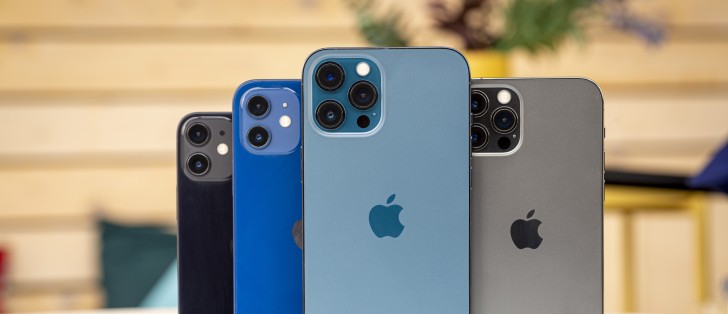Apple iPhone 12 Pro Max review

Portrait quality
The Portraits on the Apple iPhone 12 Pro Max are shot with the telephoto camera by default, but you can switch to the main snapper any time you need a wider photo. The LiDAR Scanner is of a big help here as it creates an incredibly detailed depth map for the camera to use, and subject separation is supposed to be near perfect.

Also, thanks to the LiDAR being independent of the available light, the iPhone 12 Pro Max can again do Night Mode portraits. But one thing should be very clear - Night Mode for portraits works only on the main camera. If you switch to Portrait mode - it always defaults on 2.5x zoom - and if it's dark, you will see the Night Mode icon appear. But once you tap on that, the camera will switch to the primary one.
The portraits shot with the tele camera are excellent, better than what we got with the regular Pro model. They are very detailed, with great contrast and colors. The subject separation is admirable, and the defocused parts are quite pleasant.
The improved depth map does matter a lot when applying portrait effects, though. These artsy photos have never looked better, from the first take at that!
The portraits from the main camera are pretty good, too, on par with the best in the business.
Now, let's look at some Night Mode portraits. As we mentioned, those are shot on the primary camera, and the phone usually chooses 1s or 2s exposure. You can tweak this up to 5s-10s, but we don't think your subject can stay still for that long.
The iPhone 12 Pro Max shoots the Night Portraits we expected from the regular Pro but didn't get. Those are simply outstanding (for low-light shots). There is plenty of detail, incredibly low noise levels, excellent subject separation, and lovely looking blur, restored highlights where necessary, and no traces of handshake whatsoever.
The images are as bright as they need to be, and the colors are nothing short of fantastic.
Overall, the iPhone 12 Pro Max offers some massive potential for low-light photography, including portraits. You just need to open your creative side and tap into that.
And here are a couple of regular portraits taken with the telephoto camera at low-light - just for comparison's sake.
Selfies
The latest Apple selfie camera offers two Field-of-View settings on the viewfinder - the slightly zoomed-in 7MP crop that is equivalent to a 30mm field of view and full 12MP mode, which has a 23mm equivalent FoV.
If you hold the phone in portrait orientation, selfies are cropped to 7MP to provide a tighter framing but rotate the phone horizontally, and you get more of the scene with the phone automatically switching to the wider 12MP mode. You can also switch between those two modes manually by tapping on the arrows near the shutter button.
The 12MP selfies we took with the iPhone 12 Pro Max are excellent - they are rich in detail and with quite high contrast, the colors are true to life, and the noise is handled very well. The dynamic range is above average, though not over the top and the images look balanced.
You can shoot selfie portraits, and they would turn up excellent. The camera is assisted by the structured-light 3D scanner and uses a detailed depth map, so the subject separation and the defocused background are among the best you can have on a selfie today. The quality remains the same as the regular photos. These portraits are shot in 7MP, meaning the camera crops a part of its available FoV and shows a zoomed-in shot.
Night Mode now works on the selfie camera, too, and it successfully brightens the photo and exposes more detail. The images are rather soft and noisy, though.




NM Auto • NM OFF • NM Auto • NM OFF
Video recording and quality
The Apple iPhone 12 Pro Max captures video at various resolutions and framerates with all four cameras, and it can even do it simultaneously if you have the right multi-cam app.
All videos are digitally stabilized thanks to the EIS plus sensor-shift (main) or optical (telephoto) stabilization where available. All modes, including the 4K@60fps, feature an expanded dynamic range thanks to the Smart HDR. The slow-mo options max out at 1080p at 240fps.
The entire iPhone 12 series is the first to allow video capture straight into the Dolby Vision dynamic HDR video format, and the Pro Max can do HDR video capturing is available in all resolutions at both 30fps and 60fps. You can edit these videos on-the-go on your phone, you can upload them on YouTube or any other popular platform, or even send them to your friends.
The Dolby Vision information is saved outside of the video stream, so the original Dolby Vision video could be played on any non-HDR player/screen even if it will look lacking in dynamic range and colors. At the same time, it will be color-boosted on any Dolby Vision-compatible player and display.
Here are a few tips from us if you opt for capturing in Dolby Vision (HDR video in settings). If you want to transfer untouched Dolby Vision video files to your computer, your iPhone transfer options should be set to Keep Originals. Otherwise, with Most Compatible, you will always copy a converted on the go non-HDR video for better compatibility.
Now about the playback. If your display isn't Dolby Vision-capable, but you've transferred original Dolby Vision files - those will still play. They appear with low dynamic range and duller colors compared to non-HDR or converted (Most Compatible) files, but they'll play. And if you don't own DV-capable equipment, just disable HDR capturing and forget about tinkering with Settings.
The iPhone 12 Pro Max captures wide stereo audio for the videos at a bitrate between 128kbps and 160kbps. This means spatial sound, just like some HTCs and some old Nokia phones did, as well as the iPhone 11 Pro duo, and you should enjoy richer and deeper sound if compared to just regular stereo.
The 4K videos captured both at 60 and 30 fps with the main camera are lively with excellent contrast, low noise, outstanding dynamic range, and accurate colors and white balance. In fact, the colors stay the same across the footage coming from all cameras - just as Apple promises.
The videos aren't flawless, though. Rendering fine detail isn't that great, especially for a flagship of such caliber. The picture is okay, and there is enough detail, but the foliage once again looks overprocessed and just doesn't look good.
The 4K footage from the ultrawide snapper has mediocre detail around the center, and it gets rather worse towards the corners even if those are not warped. On a positive note, the dynamic range, colors, and contrast are superb, as usual.
The telephoto cam captures excellent videos. Those are rich in detail, and with low noise, the foliage looks better (probably because it is zoomed-in). The contrast and dynamic range remain impressive, and the colors accurate to both the scene and the other cameras.
Apple's cinematic stabilization is available on all cameras, resolutions, and fps options. It works fantastically, as it always has been on the iPhones. The video below was shot on the main camera, which uses both IBIS and EIS, and the result is outstanding.
The low-light 4K videos are great - they are detailed enough and look the same as what we observed with the regular iPhone 12 Pro and 12. The colors are good with pleasant saturation, while the noise is kept low enough. We've seen a couple of flagships do better, but we've also seen many do worse.
The nighttime 4K footage from the ultrawide camera is of rather poor quality, though, while the telephoto camera doesn't capture videos at night.
All iPhone 12 phones can all do Night-Mode Time-lapse with their primary camera. You just select Time-lapse, mount your iPhone on a tripod, and hit the shutter. The camera app offers no settings whatsoever, and the videos are saved in 1080p@30fps format. We shot two low-light time-lapse videos - each of them took about 33 minutes, compressed into 33 seconds. And those clips are stunning. Everything looks great - very detailed, the noise is absent, and the exposure proficiently changes when needed.
And here is a selfies 4K sample from the front camera. The clip is very good in detail and excels in everything else.
You can also look at our video compare tool and see how the iPhone 12 mini stands against some of its rivals.



4K: Apple iPhone 12 Pro Max vs. Apple iPhone 11 Pro Max and Apple iPhone XS Pro Max in our Video compare tool
Reader comments
- James
- 24 Apr 2025
- r3y
Yes I need it so much
- Anonymous
- 23 Dec 2024
- JFD
iPhone12 is the Best
- Emem
- 03 Nov 2024
- XBB
Are you serious?
























